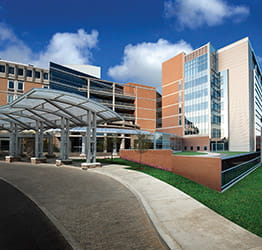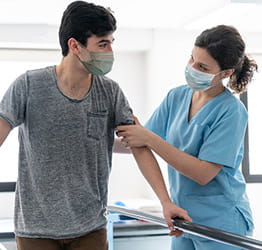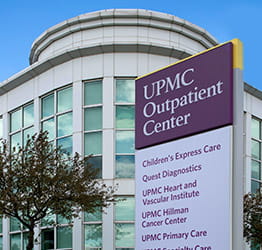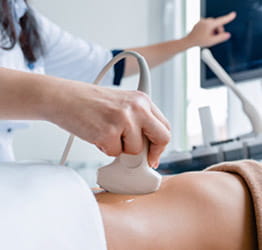What Is Nuclear Medicine?
Nuclear medicine imaging procedures are noninvasive tests that use small, harmless amounts of radioactive material to help doctors diagnose or treat a variety of medical conditions, including cancer, bone lesions, heart disease, and other abnormalities. These tests differ from other imaging tests because they show how organs function rather than how they appear.
How does nuclear medicine work?
Nuclear medicine uses radioactive materials called radiopharmaceuticals or radiotracers.
Depending on the type of nuclear medicine test or treatment you are having, the radiotracer is either:
- Inhaled as a gas.
- Injected into your vein.
- Swallowed.
The radiotracer emits energy in the form of gamma rays, which is detected by a device called a gamma camera and/or probe. These devices work together with a computer to measure the amount of radiotracer absorbed by the body and produce special images offering details on the structure and function of organs and tissues.
Types of nuclear medicine imaging
Nuclear medicine imaging tests include:
- Back (SPECT) scan — Looks for fractures and tumors in the spine.
- Bone scan — Assesses degenerative or arthritic changes in your joints, detects bone diseases or tumors, and finds the cause of bone pain or swelling.
- Brain scan — Looks for problems within the brain or with blood circulation to the brain.
- Cardiac stress test — Shows how blood moves through your heart at rest and during exercise.
- DMSA scan (renal scan) — Looks for problems with kidney function and structure.
- Gallbladder scan — Checks for problems with the function and structure of your gallbladder.
- Gastric emptying test (GET) — Measures the speed with which food empties from your stomach.
- GI bleed scan (GIBS) — Locates active bleeding in your GI tract.
- Heart scan — Finds abnormal blood flow to the heart, measures heart function, or shows the extent of damage after a heart attack.
- HIDA (hepatobiliary iminodiacetic acid) scan — Takes pictures of your liver, gallbladder, bile ducts, and small intestine.
- Melanoma sentinel node — Identifies the sentinel node during surgery to determine if melanoma has spread to nearby lymph nodes.
- MUGA scan — Shows the function of the left ventricle of the heart.
- Parathyroid scan — Studies tumors in the parathyroid gland.
- Sodium-fluoride PET scan — Diagnoses bone and joint problems, such as tumors.
- Thyroid scan — Tests your thyroid function.
- VQ (lung ventilation–perfusion) scan — Looks at the air and blood flow in your lungs.
- White cell location scan — Identifies infection or inflammation in your body.
Conditions we diagnose and treat with nuclear medicine
Nuclear medicine is used to treat disorders of the:
- Bone
- Brain
- Gallbladder
- Gastrointestinal tract
- Heart
- Kidneys
- Lungs
- Spine
- Thyroid
Why Would I Need Nuclear Medicine Imaging?
You may need a nuclear medicine imaging if your doctor suspects you have cancer, heart disease, bone lesions, or other disorders.
Who’s a candidate for nuclear medicine imaging?
You may be a candidate for a nuclear medicine imaging test if your doctor suspects you have a condition that can’t be accurately diagnosed using traditional imaging tests.
What Are the Risks and Complications of Nuclear Medicine Imaging?
Nuclear medicine imaging uses safe amounts of radioactive materials.
However, like many medical tests, nuclear medicine studies come with some risks, including:
- Allergic reaction to radioactive substances or medications.
- Radiation exposure.
What Should I Expect From Nuclear Medicine Imaging?
Before: How to prepare for nuclear imaging
If you're claustrophobic or fear enclosed spaces, talk to your doctor before your test day. They can prescribe mild sedation to help you relax during the procedure.
Before your nuclear imaging test starts:
- Tell your imaging technologist if you're pregnant or think you might be pregnant. Radiation can be harmful to an unborn baby.
- Your technologist will ask you questions about your health and any past surgeries.
- You'll also have a chance to ask any questions about the test.
- You'll put on a hospital gown and take off any jewelry or metal.
Your doctor will give you details on how to prep based on the type of test you're having.
How long does nuclear medicine imaging take?
The length of time for nuclear medicine imaging tests varies depending on the type of exam. The actual scanning time can take from 20 minutes to several hours and may be conducted over several days.
During your nuclear medicine imaging procedure
Except for minor discomfort during any necessary intravenous injections, most nuclear medicine procedures are painless and are rarely associated with significant discomfort or side effects.
- When the radioactive material is injected into your arm, you may feel a cold sensation moving up your arm, but there are generally no other side effects.
- When swallowed, the radiotracer has little or no taste.
- When inhaled, you should feel no different than when breathing room air or holding your breath.
During the test, you will need to remain still for brief periods.
When it's time for the imaging to begin, the gamma camera:
- Will take a series of images.
- May move down the body, rotate around you, or stay in one position.
- May move very close to your body to obtain the best quality images.
Different nuclear medicine imaging tests have different purposes, preparation instructions, and procedures, including:
Bone scan
Bone scans find:
You don't need to do anything special to prepare for a bone scan. However, you should drink extra fluids and pee often between the shot and scan. You'll also receive an IV.
Your scan can take three to four hours, depending on the bones that need to be scanned.
Gastric emptying test (GET)
These tests show the movement of solids or liquids from your stomach into your small intestine.
Instructions to prepare for a GET can vary but may include:
- No eating, drinking, or caffeine for six hours before the study.
- No smoking on the morning of the test or during the study.
- Not taking certain stomach medicine and narcotics two days before the study.
For the study, your technologist will give you a small amount of food tagged with a tasteless radioactive material, such as:
- Eggs, toast with jam, and 2 oz. of water.
- Two scrambled eggs and 2 oz. of water.
If you're allergic to eggs, we can give you Ensure to drink. The study typically takes between four and five hours to complete.
HIDA scan
HIDA scans show the function of the gallbladder.
Common ways to prepare before your HIDA scan include:
- Having an ultrasound within six months of the scan.
- No eating or drinking for six hours before the scan.
- No narcotics for 12 hours before the scan.
You'll receive an IV on the day of your HIDA scan. The test takes 90 minutes to four hours.
Renal scan
Renal scans assess:
Test preparation often includes:
- Drinking extra fluids.
- Not taking certain medicines — such as ACE inhibitors or water pills — for 48 hours before your scan.
On the day of your renal scan, you'll have an IV or a Foley catheter. The scan takes between 20 minutes and two hours.
Stress test
Stress tests measure your blood flow and the function of your heart muscle.
Your doctor will give you specific instructions before your test. They may include not eating, drinking, or taking certain medicines within a few hours of your test.
You'll have your stress test at the hospital. It takes about two to three hours.
Thyroid uptake and scan
Thyroid uptakes and scans look at the size, shape, location, and function of the thyroid gland.
Preparation can vary, but may include:
- No amiodarone for 3-6 months before your scan.
- No eating or drinking for four hours before your scan.
- No IV contrast dye for 12 weeks before your scan.
- No multivitamins for two weeks before your scan.
- No thyroid medicine for three days to four weeks before your scan, based on the drug you take.
On your test day, we may give you a pill or an IV. The uptake and scan take more than 24 hours from start to finish.
VQ scan
VQ scans detect pulmonary embolism (blood clots in the lungs). You'll have this test at the hospital.
With most VQ scans, you'll need to:
- Get a chest x-ray within 24 hours of the VQ scan.
- Have a temporary IV set up.
- Lie flat during the scan, which takes about 45 minutes.
Recovery after nuclear medicine imaging
When your examination is complete, your radiologist or cardiologist will interpret the results and determine if additional images are needed. Occasionally, more images are obtained to clarify or better visualize certain areas or structures.
Before you leave the nuclear medicine department, your radiologist or a physician will inform you of any special instructions. Usually, you can resume your normal activities after your nuclear medicine scan, unless your doctor tells you otherwise.
When to call your doctor about complications
You should contact your doctor if you have signs of infection or other complications, including:
- Severe pain, swelling, or redness at the injection site.
- Skin irritation, hives, or other symptoms of an allergic reaction. If symptoms are severe, dial 911.
Why Choose UPMC for Nuclear Medicine Imaging?
When you choose UPMC for nuclear medicine imaging, you will receive:
- Access to advanced imaging technology — Our experts use the latest imaging technology to quickly and accurately diagnose and treat a full range of health conditions.
- Convenient imaging services — Imaging appointments are available at multiple locations with hours that fit your schedule.
- Multidisciplinary care — We partner with surgeons, oncologists, cardiologists, neurologists, nephrologists, gastroenterologists, and other medical experts to treat a full range of medical conditions.
By UPMC Editorial Staff. Last reviewed on 2025-08-28.
















